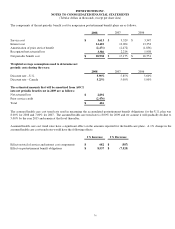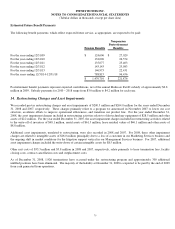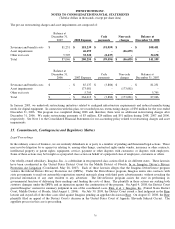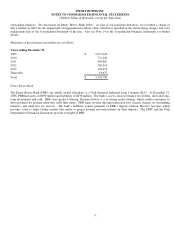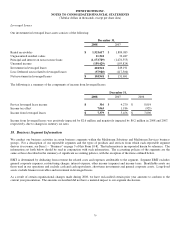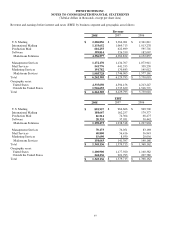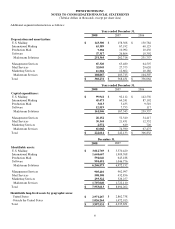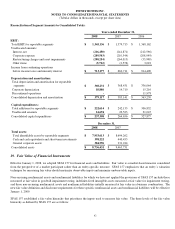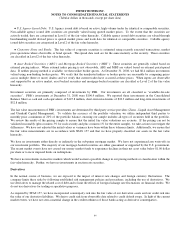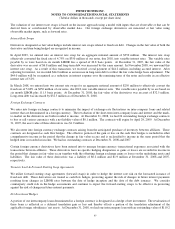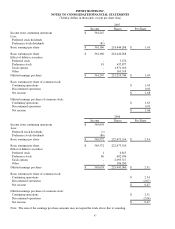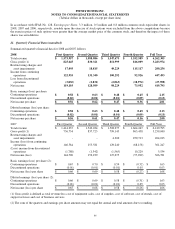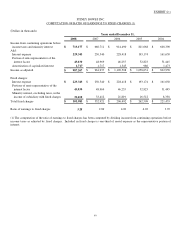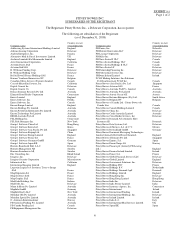Pitney Bowes 2008 Annual Report Download - page 102
Download and view the complete annual report
Please find page 102 of the 2008 Pitney Bowes annual report below. You can navigate through the pages in the report by either clicking on the pages listed below, or by using the keyword search tool below to find specific information within the annual report.
PITNEY BOWES INC.
NOTES TO CONSOLIDATED FINANCIAL STATEMENTS
(Tabular dollars in thousands, except per share data)
83
Level 1 – Unadjusted quoted prices in active markets for identical assets and liabilities. Examples of Level 1 assets include
money market securities and U.S. Treasury securities.
Level 2 – Observable inputs other than Level 1 inputs such as quoted prices for similar assets or liabilities; quoted prices in
markets that trade infrequently; or other inputs that are observable or can be corroborated by observable market data for substantially
the full term of the assets or liabilities. Examples of Level 2 assets and liabilities include derivative contracts whose values are
determined using a model with inputs that are observable in the market or can be derived from or corroborated by observable market
data, mortgage-backed securities, asset backed securities, U.S. agency securities, and corporate notes and bonds.
Level 3 – Unobservable inputs that are supported by little or no market activity and that are significant to the fair value of the
asset or liability. These inputs may be derived with internally developed methodologies that result in management’s best estimate of
fair value. During the twelve months ended December 31, 2008 we had no Level 3 recurring measurements.
The following table shows, by level within the fair value hierarchy, our financial assets and liabilities that are accounted for at fair
value on a recurring basis at December 31, 2008. As required by SFAS 157, financial assets and liabilities are classified in their
entirety based on the lowest level of input that is significant to the fair value measurement. Our assessment of the significance of a
particular input to the fair value measurement requires judgment and may affect their placement within the fair value hierarchy levels.
Recurring Fair Value Measurements at December 31, 2008 by Level
Level 1 Level 2 Level 3 Total
Assets:
Investment securities
Money market funds $ 181,664 $ - $ - $ 181,664
U.S. Government and agency issued debt 30,583 11,433 - 42,016
Corporate notes and bonds - 4,725 - 4,725
Asset backed securities - 2,658 - 2,658
Mortgage-backed securities - 21,713 - 21,713
Derivatives
Interest rate swaps - 32,486 - 32,486
Total assets $ 212,247 $ 73,015 $ - $ 285,262
Liabilities:
Derivatives
Foreign exchange contracts $ - $ (286) $ - $ (286)
Treasury lock and forward starting swaps - (31,326) - (31,326)
Total liabilities $ - $ (31,612) $ - $ (31,612)
Investment Securities
For our investments, we use the market approach for recurring fair value measurements and the valuation techniques use inputs that
are observable, or can be corroborated by observable data, in an active marketplace.
The following information relates to our classification into the fair value hierarchy:
● Money Market Funds: Money market funds typically invest in government securities, certificates of deposit, commercial paper
of companies and other highly liquid and low-risk securities. Money market funds are principally used for overnight deposits and are
classified in Level 1 of the fair value hierarchy.
● U.S. Government Issued Debts: U.S. Governmental securities are valued using active, high volume trades for identical securities.
Valuation adjustments are not applied so these securities are classified in Level 1 of the fair value hierarchy.



